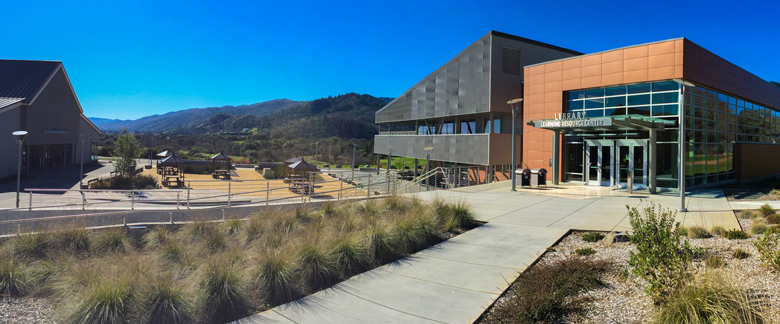
How Mendocino College deployed a modern data architecture to understand and guide the entire student journey
SUMMARY

Mendocino College leaders were eager for insights to improve resource planning—especially as they were trying to gauge student readiness to return to campus in the spring of 2022. But their existing data warehouse solution was like a “black box” that produced only the most recent updates from its traditional data tables. They needed more data on the entire student journey along the way. With InvokeClarity™, Mendocino College now has a modern solution built for higher education that could capture comprehensive daily snapshots, retain these important historical data points, and allow them to see real-time trends to guide strategic decision-making. EDUCAUSE recognized this work in its 2022 Horizon Report: Data and Analytics Edition (see “Modern Data Architecture”).
About Mendocino College
- Part of Mendocino-Lake Community College District, based in Ukiah, California
- 3,589 students (as of fall 2021)
- Serving students on the main campus, three centers, and online
QUESTIONS
In the spring of 2022, Mendocino College was starting to book more classes on campus. They believed that, following the pandemic-era shift to online courses, students were now ready to come back for in-person instruction—but this was based on limited data.
“Anecdotally, we heard from students in the fall that they preferred in-person classes to online classes, so as COVID-19 began to diminish, we built a spring schedule that was more in-person,” said Dave Johnston, Director of Information Technology.
“We came to find out many students weren’t ready to resume on-ground classes after all … and we had to cancel a bunch of them.”
Mendocino’s reports could tell stakeholders that students hadn’t enrolled in on-campus classes at the expected rates. But those reports couldn’t catch in real time that enrollment was trending below expectations.
As for the nuances of why students might not be ready to come back, student interviews could provide those insights—but only after a costly mismatch between student needs and class schedule planning had occurred.
Like many institutions of higher education, Mendocino College often had to rely on manual processes to get critical information from each system. They wanted to be able to more quickly make time-sensitive decisions, use data from more available systems, and take strategic action on enrollment and student support.
Often, they relied on faculty to initiate these processes:
- Instructors and administrators would monitor the enrollment in their upcoming classes to ensure they had sufficient students to be financially viable. If students dropped or new students weren’t registering fast enough, instructors might reach out to contacts in the community to encourage additional students to register.
- Instructors were also responsible for reporting to an “early alert” system, which identified students who might need additional support, and issuing a referral.
Mendocino’s leaders value the human intuition at the center of recruitment actions and referral decisions. However, they also believed that a better system to provide automated, real-time data from multiple systems could help provide earlier alerts to support more targeted human intervention.
Researchers at Mendocino College needed a better way to identify challenges in the student journey as they are happening, from enrollment to student success and equitable achievement outcomes.
- How can we better anticipate student enrollment to build out the optimal class schedule?
- What strategies might make the most sense to try to boost enrollment numbers?
- How can we improve our early alert process to get students the support they need sooner?
THE CHALLENGE
“You need a lot of data to draw patterns, fast enough to see that some changes need to happen. Whether that’s additional marketing or reaching out to students who have not yet registered, there are lots of things we could do.”
Mendocino’s institutional researchers had access to reports that were generated by a traditional data warehouse solution. But it had frustrating limitations, including deficits in historical reliability that made trend analysis practically impossible.
“It was created by a third-party consultant before any of the people that are here now arrived, so it’s sort of a black box. It had a number of problems. It took nightly snapshots, but sometimes, it wouldn’t copy the data to the data warehouse,” Johnston said. “But the biggest issue was that it was limited in scope and gave us no longitudinal data.”
Even when the system worked properly, those nightly snapshots were only the most recent updates of data tables. The warehouse didn’t preserve previous iterations. So all Johnston and his colleagues in institutional research could see was the end point, not the journey.
Consider one student’s story through the lens of her grade point average. If all you can see is her GPA at the end of each semester, you’re missing the progression of that student’s journey.
- Which assignments, quizzes and tests did she struggle with along the way?
- What effect did her first tutoring or group study session have on her grades the following week?
- Or after her first, second, and third academic counseling sessions?
To get answers to questions like these, Mendocino College needed data that looked more like an instructor’s grade book, showing how the GPA progressed over time. Then, they could place those dated entries beside supplemental records, such as the dates of academic counseling sessions.
But their traditional data warehouse didn’t support this. It was like trying to read a book when the words on the page were constantly changing. Institutional researchers couldn’t even begin to ask the kinds of questions they wanted to.
Stakeholders faced the same limitations in asking enrollment questions. When all you can see are the most up-to-date enrollment numbers, that tells you nothing about the progression of enrollment progress over time.
“We couldn’t look back and see that, say, on the 23rd day of the enrollment period for the fall, what did we look like on that day the fall before? You need a lot of data to draw meaningful patterns, fast enough to see that some changes need to happen. Whether that’s additional marketing or reaching out to students who have not yet registered, there are lots of things we could do,” Johnston said.
THE SOLUTION
“I’ve worked on a lot of technology projects, and I’ll say deploying the InvokeClarity™ data lakehouse was one of the easiest … We were starting to see data come in within two or three weeks.”
To gain access to the real-time data it takes to inform timely decisions about enrollment planning, student success, adding equity gaps and more, Mendocino College needed to modernize its data architecture.
InvokeClarity™, a “data lakehouse” platform designed specifically for higher education, provided Mendocino College with just the kind of rapid data intake, central warehousing, daily reporting, and analytic research capabilities that Johnston and his colleagues were hoping to find—a cutting edge solution scalable to a price point suitable for a small college budget.
It didn’t take long before Mendocino College was up and running with InvokeClarity™.
“I’ve worked on a lot of technology projects, and I’ll say deploying the InvokeClarity™ data lakehouse was one of the easiest. The Invoke Learning team was great. It was a really good learning experience for my team, too. They came away from the experience much more familiar with our data than they were before they went through that process,” Johnston said.
“And it was a really quick process. With some of the projects we deal with, my team does a lot of work to make connections with the vendor. That was not the case with Invoke Learning. We were starting to see data come online within two or three weeks.”
THE ANSWERS
“InvokeClarity™ organizes data really well … Often, everything we need, even from different systems, can be found in just one table.”
With InvokeClarity™, Mendocino College stakeholders are getting access to real-time and historically stable data from multiple sources, which allows them to analyze trends in student behavior from enrollment and beyond like never before.
On-Demand Access to Real-Time Student Data
The platform dramatically simplifies the task of “querying” their data, pulling what they need for reports. In the past, researchers would need help from Johnston’s team to carefully join data tables in their data warehouse, which required an understanding of structured query language (SQL).
But with InvokeClarity™, no “joins” are necessary. All the data normally found in a 100-table traditional or cloud-based student warehouse can be found in a simple handful of comprehensive and intuitive tables. And it’s enriched with data from multiple internal and public sources. This allows researchers who aren’t proficient in SQL to easily compare data any way they want to and create custom reports with minimal assistance.
Longitudinal Data to Analyze Trends
“The reliability of the data with InvokeClarity™ is so much better than what we had before. Because we have those snapshots of all history every day, every bit of that data is available longitudinally, so we can start to do really interesting analysis of everything over time,” Johnston said.
Easy Comparison of Disparate Student Data
“InvokeClarity™ organizes data really well. Maybe you’re connecting a student with courses and grades. Before, you would need a lot of help from the IT team to be able to create the queries you wanted, because you’d run into lots of nerdy idiosyncrasies like artificial duplication,” Johnston explained.
“But in the InvokeClarity™ data lakehouse, all that stuff is already taken care of. Often, everything we need, even from different systems, can be found in just one table. All the data you need for different analyses around students in courses within a semester and across time are in one place.”
THE RESULTS
With its new modern data architecture, Mendocino College now has the capability to easily use data from multiple sources with a snapshot every day, enabling stakeholders to track trends in enrollment, engagement, and student success to improve resource planning.
Johnston is excited to have a platform that can provide answers to the questions his leadership is asking related to why enrollments don’t hit targets, why equity gaps exist between student segments, and how to begin to more strategically address these issues.
Enrollment & Retention
“We’ll be able to see where we stand today versus last semester, versus last year, to see if the predictions we made of what this semester is going to look like are holding true. We’ll be able to use our tools to reach out to students that haven’t registered yet. And if we’re starting to lose students in the middle of a semester, we can give them the resources they need and encourage them to persist.”
Engagement & Student Success
“As students start to disengage, maybe not spending as much time in Canvas (the learning management system) as they had been, we’ll be able to identify them earlier and touch base with the instructor to determine exactly what the student needs. Whether it’s financial issues, job changes, childcare issues, or whatever it is, we can find out what’s going on and determine how we can help them be successful.”
Student Equity
“Community colleges like ours are limited in resources for social research. So especially for us, InvokeClarity™ is a game-changing solution that gives us access to the data we need to identify the students that need support. I would definitely recommend it to any higher education research leader.”
Mendocino College is leading the way.
What’s holding you back today from taking your mission further tomorrow? Find out—and discover just how far you can go.
